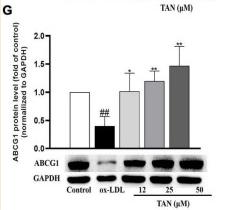ABCG1 Antibody - #DF7693
| Product: | ABCG1 Antibody |
| Catalog: | DF7693 |
| Description: | Rabbit polyclonal antibody to ABCG1 |
| Application: | WB |
| Cited expt.: | WB |
| Reactivity: | Human |
| Prediction: | Pig, Zebrafish, Bovine, Horse, Sheep, Dog, Chicken |
| Mol.Wt.: | 110 kDa; 76kD(Calculated). |
| Uniprot: | P45844 |
| RRID: | AB_2841164 |
Related Downloads
Protocols
Product Info
*The optimal dilutions should be determined by the end user.
*Tips:
WB: For western blot detection of denatured protein samples. IHC: For immunohistochemical detection of paraffin sections (IHC-p) or frozen sections (IHC-f) of tissue samples. IF/ICC: For immunofluorescence detection of cell samples. ELISA(peptide): For ELISA detection of antigenic peptide.
Cite Format: Affinity Biosciences Cat# DF7693, RRID:AB_2841164.
Fold/Unfold
ABC transporter 8; ABC8; ABCG1; ABCG1_HUMAN; ATP-binding cassette sub family G member 1; ATP-binding cassette sub-family G member 1; ATP-binding cassette transporter 8; ATP-binding cassette transporter member 1 of subfamily G; ATP-binding cassette, sub family G WHITE member 1; homolog of Drosophila white; MGC34313; White protein homolog; White protein homolog ATP binding cassette transporter 8; WHITE1; WHT1;
Immunogens
A synthesized peptide derived from human ABCG1, corresponding to a region within the internal amino acids.
Expressed in several tissues. Expressed in macrophages; expression is increased in macrophages from patients with Tangier disease.
- P45844 ABCG1_HUMAN:
- Protein BLAST With
- NCBI/
- ExPASy/
- Uniprot
MACLMAAFSVGTAMNASSYSAEMTEPKSVCVSVDEVVSSNMEATETDLLNGHLKKVDNNLTEAQRFSSLPRRAAVNIEFRDLSYSVPEGPWWRKKGYKTLLKGISGKFNSGELVAIMGPSGAGKSTLMNILAGYRETGMKGAVLINGLPRDLRCFRKVSCYIMQDDMLLPHLTVQEAMMVSAHLKLQEKDEGRREMVKEILTALGLLSCANTRTGSLSGGQRKRLAIALELVNNPPVMFFDEPTSGLDSASCFQVVSLMKGLAQGGRSIICTIHQPSAKLFELFDQLYVLSQGQCVYRGKVCNLVPYLRDLGLNCPTYHNPADFVMEVASGEYGDQNSRLVRAVREGMCDSDHKRDLGGDAEVNPFLWHRPSEEVKQTKRLKGLRKDSSSMEGCHSFSASCLTQFCILFKRTFLSIMRDSVLTHLRITSHIGIGLLIGLLYLGIGNEAKKVLSNSGFLFFSMLFLMFAALMPTVLTFPLEMGVFLREHLNYWYSLKAYYLAKTMADVPFQIMFPVAYCSIVYWMTSQPSDAVRFVLFAALGTMTSLVAQSLGLLIGAASTSLQVATFVGPVTAIPVLLFSGFFVSFDTIPTYLQWMSYISYVRYGFEGVILSIYGLDREDLHCDIDETCHFQKSEAILRELDVENAKLYLDFIVLGIFFISLRLIAYFVLRYKIRAER
Predictions
Score>80(red) has high confidence and is suggested to be used for WB detection. *The prediction model is mainly based on the alignment of immunogen sequences, the results are for reference only, not as the basis of quality assurance.
High(score>80) Medium(80>score>50) Low(score<50) No confidence
Research Backgrounds
Catalyzes the efflux of phospholipids such as sphingomyelin, cholesterol and its oxygenated derivatives like 7beta-hydroxycholesterol and this transport is coupled to hydrlysis of ATP. The lipid efflux is ALB-dependent. Is an active component of the macrophage lipid export complex. Could also be involved in intracellular lipid transport processes. The role in cellular lipid homeostasis may not be limited to macrophages. Prevents cell death by transporting cytotoxic 7beta-hydroxycholesterol.
Palmitoylation at Cys-315 seems important for trafficking from the endoplasmic reticulum.
Endoplasmic reticulum membrane>Multi-pass membrane protein. Golgi apparatus membrane>Multi-pass membrane protein. Cell membrane.
Note: Predominantly localized in the intracellular compartments mainly associated with the endoplasmic reticulum (ER) and Golgi membranes.
Expressed in several tissues. Expressed in macrophages; expression is increased in macrophages from patients with Tangier disease.
Belongs to the ABC transporter superfamily. ABCG family. Eye pigment precursor importer (TC 3.A.1.204) subfamily.
Research Fields
· Environmental Information Processing > Membrane transport > ABC transporters.
References
Application: WB Species: Mice Sample: RAW264.7 cells
Restrictive clause
Affinity Biosciences tests all products strictly. Citations are provided as a resource for additional applications that have not been validated by Affinity Biosciences. Please choose the appropriate format for each application and consult Materials and Methods sections for additional details about the use of any product in these publications.
For Research Use Only.
Not for use in diagnostic or therapeutic procedures. Not for resale. Not for distribution without written consent. Affinity Biosciences will not be held responsible for patent infringement or other violations that may occur with the use of our products. Affinity Biosciences, Affinity Biosciences Logo and all other trademarks are the property of Affinity Biosciences LTD.
